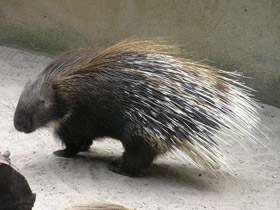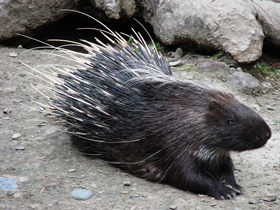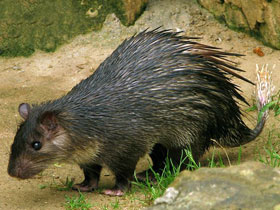Porcupines
The porcupine is the prickliest of rodents, though its Latin name means "quill pig." Porcupines have soft hair, but on their back, sides, and tail it is usually mixed with long, sharp quills. Porcupines do not attack their enemies, but rather use their spines as a means of defence. Porcupines are slow, clumsy animals that are not as smart as many other rodents and their spines are the only means of protection against predators. When attacked or annoyed, the porcupine raises its spines and rattles them vigorously to scare off the predator. If this does not work, the porcupine charges backward at its enemy. The porcupine’s quills detach easily, and once the barbed tips dig into the flesh of the attacker they are almost impossible to remove. The body heat from the predator causes the quills to swell inside their skin making removal even more difficult. Sometimes the predator starves to death because the quills irritate it so much that it can not hunt, eat, or rest.
There are two families of porcupines found in two main regions of the world, so scientists group them into either Old World or New World porcupines. Old World porcupines live in Europe, Africa, and Asia. New World porcupines live in North, Central, and South America; the New World porcupines are perfect tree climbers.
Family Hystricidae – Old World porcupines
The Indian crested porcupine Hystrix leucura
The Indian crested porcupine is a very large rodent with the body length from 70 to 90 cm. The undersides of its body, limbs, neck, head, and shoulders are covered in rough bristles, while long, hard upright spines are growing from the middle part of the head, with longer quills being found near the rear of the animal. The front part of the body is covered in longer bristles, while hard spindly quills (that are 30 to 300 mm long) are densely packed over the Indian crested porcupine’s rump and back. Shorter, thick and rigid quills are scattered across those long quills. When alarmed or annoyed, the Indian porcupine raises its quills and rattles the hollow spines on its tail. The Indian crested porcupine is found in arid territories of Middle and Central Asia, Pakistan, India, Nepal, China, and Sri Lanka. This rodent occurs in the foothills and low mountains at elevations of up to 2,400 meters above sea level but it may also live in lowlands where it prefers riversides habitats. The Indian crested porcupine is solitary animal that digs burrows that have quite complex structure, with a total length of the tunnels reaching 20 meters. These porcupines also find shelter in caves, rock crevices, and gullies in loessial cliffs. In summer, the Indian crested porcupine is active only in the dark time of the day but in winter it may leave its shelter also in the daytime, sometimes covering long distances in search of food. Its diet includes fruit of wild and cultivated plants, roots, stems, leaves, berries, meadow grass, tree bark, and tubers. Unlike most of other desert rodents, the Indian crested porcupine needs water. In early spring, it mostly feeds on roots, tubers, and springtime buds. With the ripening of first fruits (mulberry, apricot), the porcupine starts feeding in the gardens and consumes large amounts of fruit. In summer, it takes corn and sorghum; it also feeds in melon and pumpkin fields, sometimes seriously damaging crops. In autumn, Indian porcupines eat a lot of wild and cultivated grape and other fruit. The Indian crested porcupine does not hibernate, but is much less active in winter; in winter months, it gnaws on tree and bush bark, and also eats underground parts of grassy plants. Porcupine females usually give birth to the young in early spring; the litter size ranges between 2 and 4 babies, called porcupettes. They are not born with sharp or barbed quills; instead, the porcupette's quills are soft and bendable, gradually hardening in the first few days after birth. Young porcupines emerge from the burrows in May. They disperse in August, after which they live independently.




















































